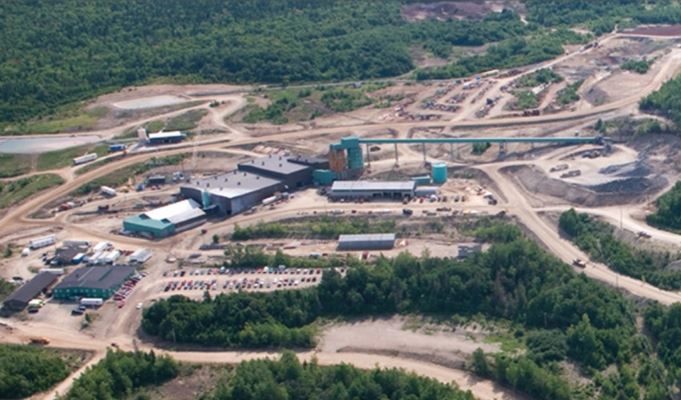Trevali encouraged by Caribou drilling results

Trevali Mining's Caribou zinc mine in the Bathurst Mining Camp of New Brunswick. Source: Trevali Mining Corp.
Trevali Mining Corp. [TV-TSX, TREVF-OTCQX, 4T1-Frankfurt, TV-LMA] has released results from the 2019 drill program at its Caribou zinc-lead-silver mine in the Bathurst Mining Camp, New Brunswick.
The surface drilling campaign, which focused on delineation and conversion of inferred mineral resources to indicated resources north of the current mineral reserves, has intersected several zones of economic zinc-lead-silver mineralization, the company said.
This indicates that mineralization is wider than previously interpreted in portions of the North Limb area and continues at mineable depths towards the north.
Highlights include:
- Hole BR-1047, which intersected 4.19 metres at 7.91% zinc, 2.54% lead and 66.50 g/t silver;
- Hole BR-1047A, which intersected 23.00 metres at 5.84% zinc, 1.93% lead and 69.25 g/t silver;
- Hole BR-107B, which intersected 29.01 metres at 6.24% zinc, 2.33% lead and 63.05 g/t silver.
Trevali shares were unchanged Tuesday at 23.5 cents and trade in a 52-week range of 16 cents and 49 cents.
Trevali is a Vancouver-based mining company. The bulk of its revenue is generated from base metals mining at four operations. They are the 90%-owned Perkoa Mine in Burkina Faso, the 90%-owned Rosh Pinah Mine in Namibia, the wholly-owned Caribou Mine, and the wholly-owned Santander Mine in Peru.
The Bathurst Mining Camp occupies a roughly circular area of approximately 70 kilometres in the Miramachi Highlights of northern New Brunswick. The area boasts some 46 mineral deposits with defined tonnage and another hundred mineral occurrences.
The Caribou Minen is located 50 kilometres west of Bathurst, and consists of an underground mine, a 3,000 tonne-per-day mill, a sulphide flotation recovery plant, a tailings management facility and other associated infrastructure.
Proven and probable reserves at the end of 2018 stood at 3.29 million tonnes, grading 6.37% zinc, 2.43% lead, 73.20 g/t silver, containing 462.5 million pounds of zinc, 176.3 million pounds of lead, and 7.7 million ounces of silver.
Measured and indicated resources stand at 9.58 million tonnes, grading 6.68% zinc, 2.55% lead, and 75.60 g/t silver. On top of that is an inferred resource of 5.12 million tonnes, grading 6.42% zinc, 2.65% lead and 78.52 g/t silver.
The mine has been in continuous production since the company restarted underground mining operations in the first quarter of 2015. Payable zinc production for the third quarter of 2019 was 20.3 million pounds, a 9% increase from the same quarter in 2018.
The Caribou deposit is a volcanogenic massive sulphide (VMS) deposit. Mineralization within the Caribou deposit is composed of seven en echelon lenses striking parallel to the Caribou fold, numbered 10 to 80. Lenses 10, 20, 30, 70 and 80 occur in the north limb of the Caribou fold, while lenses 40 and 60 are mostly on the eastern limb of the fold.
During the fall of 2019, Trevali completed 3,815 metres of drilling on the Caribou North Limb, with the goal of increasing confidence in the geological model. Previous drilling campaigns by Trevali in this area had intersected locally higher-grade mineralization.
The drill program is expected to further increase the geological confidence of the currently defined inferred mineral resource on the North Limb and will support long term mine development decisions, the company said. The large inferred mineral resource currently defined on the northern portion of the North Limb requires further definition drilling to delineate its extents towards along strike as well as at depth.
